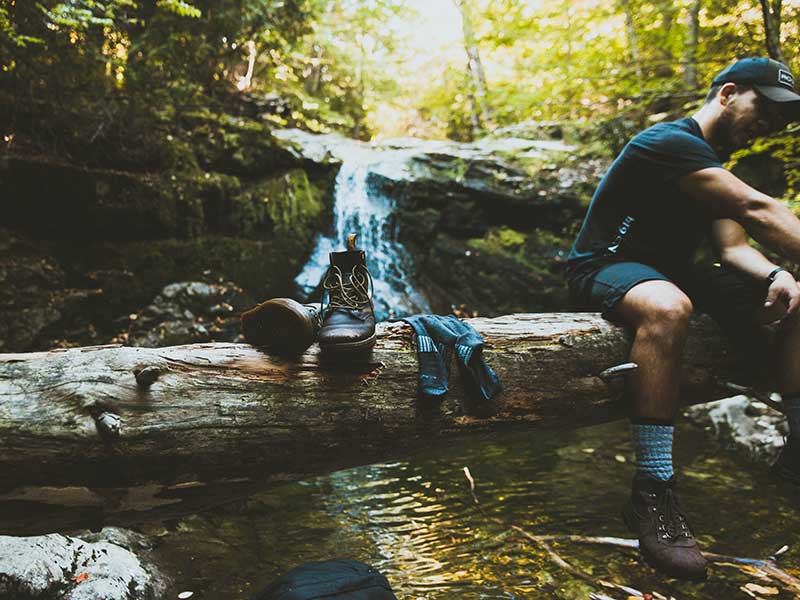3 things to consider when choosing your hiking socks

When trekking, the comfort of your feet at every step is decisive; having a good pair of shoes is a must. hiking socks is vital to take care of your feet from the blisters and provide them with shelter and comfort along the way.
Did you know that on average a person takes 2000 steps to walk one mile (1.61km), a figure that can increase due to the type of terrain you are walking? In hiking, each route, whether uphill or downhill, is a determining factor. Rocks, roots, vegetation, unevenness, you will encounter everything along the way.
How to choose your hiking socks
As you begin to select the right clothing for a hiking trip, you can consider these key aspects that will help you choose the best socks for comfortable hiking.
Consider texture and weave or fabric
The hiking socks are usually made of different materials that provide balance, warmth, durability, comfort and quick-drying ease. While most are made of polyester and nylonthe main material of manufacture is merino wooltraditional wool is very irritating and uncomfortable to wear.
In general this type of wool is the ideal material for hiking.is the most popular and most recommended by footwear experts for these sporting activities. It does not itch and regulates the temperature of the feet very well so that they do not get sweaty and have good cushioning.
A further advantage is that merino wool is naturally antimicrobial which makes it less odour retentive compared to synthetic fabrics.
It is made up of curly fibre which contains millions of air pockets that trap heat and keep the body warm.
Merino is one of the oldest breeds of sheep and its wool is used in the manufacture of sportswear. So when choosing socks for hiking, check that they are made of this material (in the highest percentage), which will guarantee good thermal capacity, softness in contact with the skin, breathability and absence of bad odours as it is an anti-bacterial material and protects against UV rays.
Merino wool is biodegradable, recyclable and renewable.
Height of hiking socks
The main purpose of a proper sock height is to protect your foot against abrasion from footwear.
The best way to choose the height of your socks is by looking at the footwear to be worn. Hiking socks come in different heights, from so short that you can't even see over your shoes to high enough to almost reach your knees.
Then, the higher the top or back of the shoe, the higher the size of the socks should be. so that you can protect your skin from rubbing against your shoes when you start your walk.
These are the heights of the hiking socks:
- None: are short socks that provide very little protection against abrasion during skin contact with the shoe. They are best worn only with lightweight, low-cut walking shoes.
- Ankle-lengthare slightly higher than short socks; they generally cover the ankle bone to provide a little extra protection. They are ideal for use with low to mid-cut shoes and boots.
- Crew: This is the classic and ideal height for hiking socks. This style reaches a few centimetres above the ankle bones to protect them from abrasion when wearing high-top shoes. They can also be worn with low-cut shoes, although if you're active on hot days, they may not only protect you from abrasion, but also make you hotter than usual.
- Knee-length: are normally worn for mountaineering. Tall socks protect against abrasion from large boots or high shoes around the calves. These socks can help keep your lower legs warm when you have to climb at night in very cold places.
Cushioning and adjustment
The amount of cushioning in a sock refers to how thick it is and how warm it can be. So the right amount of cushioning depends on the type of running you will be doing and the weather you expect to be in.
For example, some cushioning can protect your feet during high-impact activities such as running, but be aware that thicker socks are warmer and can make your feet sweat a lot.
The best thing to do at this point is to test and experiment until you find the right balance between warmth and cushioning and you can find the socks that offer you the comfort and freshness you are looking for.
There are four types of damping:
- No cushioning: are socks ultralight designed for hot climates. They are very breathable and have little padding. A model of this sock is the one from liner worn by some hikers under a hiking sock as they absorb moisture and keep feet dry. Nowadays many hiking socks work well enough that it is not necessary to wear a hiking sock under a hiking sock. liner. But if they work for you, nothing prevents you from continuing to use them.
- Light padding: great for warm conditions as they wick away moisture and provide comfort rather than overheating. They are relatively slimbut have light cushioning in key places such as the heel and ball of the foot.
- Medium cushioning: these socks provide a good amount of cushioning in the heel and ball of the foot allowing you to walk with sufficient warmth in moderate to cold weather.
- Strong cushioning: are the thickest, warmest and most cushioned socks available on the market. They are made for long journeys, difficult terrain and cold temperatures. They are very thick and warm for hiking in hot climates, but are very useful for mountaineering or cold climate travel and trekking.
Don't miss any adventure in the Pyrenees!

